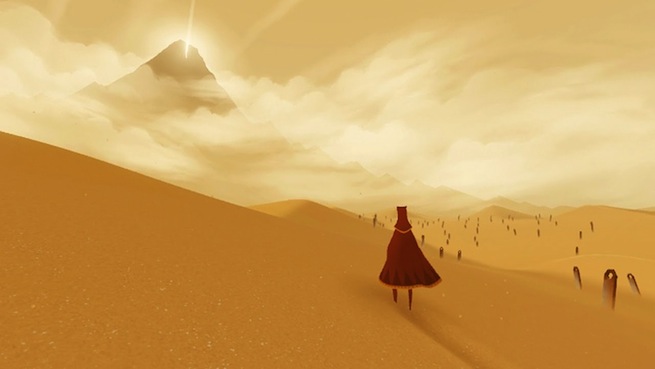Robin Hunicke (pictured below) gave a presentation at GDC Europe last week entitled “The Long Journey,” a postmortem on the making of Journey, the popular indie game for the PlayStation Network and developed by Thatgamecompany. Her presentation was reported by several high-profile websites as more negative than anything else, and GamesBeat thought it would be a good idea to check in with her to see if there was more to the story.
Hunicke’s talk illuminated some basic realities about making high-profile games — even short, affordable, downloadable ones like Journey. Hunicke was Journey’s executive producer, with a talented team of seven to 12 creative people working with her during development. Her talk covered the ups and downs that occured during the game’s production, starting with a green light from Sony and continuing through prototypes, slipping schedules, team personalities, inspirations, and reinvestment by the team. The process doesn’t sound easy, and Hunicke related many harrowing moments during production. It ends on a positive note, though, aimed at inspiring other indie game developers while keeping them grounded in the realities of production at the same time.
Journey is the best-selling game of all time on the PlayStation Network (PSN). It is a nonviolent story about a being who makes a journey through beautiful landscapes to the top of a mountain. It has no dialogue, and its uniqueness underscores the quality of the relatively small game development team that built it over several years.
GamesBeat: Your presentation had a good amount of counterbalance between positive points, and points of challenge. Why do you think the press focused so much on the negative? Do you think your presentation predisposed people to think that things went horribly wrong? Or is it more of a “bad news sells” situation? Or something totally different?
 Robin Hunicke: Working on the talk, we knew it had to present both sides of the story. It would be easy to focus on our successes, and avoid discussing our struggles. But that would not be as helpful to other developers who wanted to try making experimental games themselves. Mistakes are how you learn!
Robin Hunicke: Working on the talk, we knew it had to present both sides of the story. It would be easy to focus on our successes, and avoid discussing our struggles. But that would not be as helpful to other developers who wanted to try making experimental games themselves. Mistakes are how you learn!
In the end, the message of the talk is that making experimental games is worth it — even if the process is difficult at times. There are things you can avoid doing to remove obstacles, and others you can do to better your chances of success, such as playtesting regularly, focusing on the player’s experience, being open to the unknown, or asking hard questions about your designs. But more than anything, it takes determination. Sticking with it even when the problems are hard to solve.
Perhaps that’s just…too simple a message? Too undramatic?
GamesBeat: If you could go back and redo your presentation, would you? What, ideally, would you like audiences to know about your perspective on the process of making Journey?
Hunicke: I would not change it one bit. The talk was interesting to put together and very rewarding to give. Going over old notes, talking to the team about our struggles and triumphs — it was a chance to distill our experience into something singular. To express our belief that we can all work to build games, with passion, that push the medium forward.
I asked for a show of hands at the start of the talk — and nearly every person in the audience had played Journey. What’s more, most felt it was a meaningful experience. Afterward, many approached or wrote me to express their thanks and continued support of experimental development. What more could one ask for?
GamesBeat: Much of the talk focuses on specific solutions to challenges you faced as a team, such as “man dates” and enforced schedules, like a 10 a.m. start time. Do you think these could be implemented early on in the development of a new game? Should they become part of the process, or only used when needed?
Hunicke: Each team has its own beat, issues, and needs. If communication and coordination are among its issues, then regular 1-on-1 communication between leads and core hours are both really helpful tools for closing those gaps!
Ideally, though, a team evolves its process as problems arise. Change is the result of dialogue about which old habits need to change and which are cultural touchstones that give the team unique strengths. The most important thing is to have an open conversation, and an open mind, about the process and an unflinching focus on the ultimate goal of your game, day after day.
GamesBeat: At the end of the talk, you use the “5 Wrong, 5 Right” model. Do you think a “What went right during the making of Journey” piece would help set things straight? Or was the process a little more wrong than right? How would you characterize it to a stranger in an elevator?
Hunicke: Honestly, this talk was written for the people who attended it, and perhaps the video will inspire other perspectives. Who knows — perhaps we’ll reprise the talk at GDC in the spring, adding more technical detail; there’s plenty I couldn’t cram into this version. As for the takeaway — people who accomplish great, inspiring, or unexpected things often give the same, powerful advice: Choose your goal, and don’t give up till you get there.
Our goal was to redefine what online multiplayer game experiences could be, and we were dedicated to accomplishing that goal. It inspired our best ideas, carried us through dark times, and lead us to the light. And in the end, Journey’s production was exactly what it needed to be…and a mirror of the game itself. Often beautiful, challenging at times, ultimately transformative.
Isn’t that what life is really about?
VentureBeat's mission is to be a digital town square for technical decision-makers to gain knowledge about transformative enterprise technology and transact. Learn More

